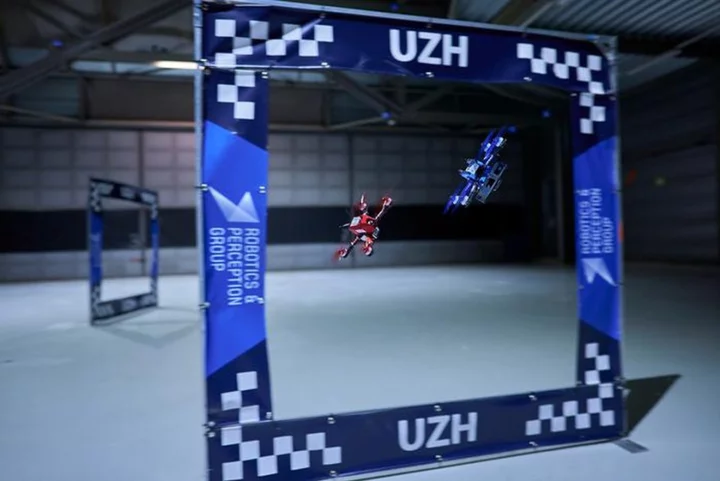
Microsoft will split Teams from Office in Europe after EU pressure
Microsoft will allow business customers in Europe to buy its video and chat app Teams separately from its Office software, it said Thursday, a month after the European Union opened an antitrust investigation into the company's bundling of the products.
2023-08-31 18:28

Sea Brings Back One of Its Top Game Titles in India After Ban
Sea Ltd. is bringing back one of its top mobile games in India a year and a half
2023-08-31 17:45

Musk Says X Will Offer Video and Audio Calls in Move Toward Super-App
Users of X, the social network formerly known as Twitter, will be able to make video and audio
2023-08-31 17:25

A dead vampire star is firing out 'cosmic cannonballs'
A dead “vampire” star is feeding on a nearby companion and expelling cannonballs and its behaviour has left astronomers stunned. The dead star is located around 4,500 light-years away and, until now, has baffled astronomers with its unusual behaviour. It is a rapidly spinning neutron star, otherwise known as a pulsar, that has been given the name PSR J1023+0038, shortened to J1023. It emits radiation from both its poles that occasionally reach Earth and also appears to have two different “settings” of brightness. Initially, the behaviour of J1023 confused experts, but now they believe that the stark difference in brightness levels has to do with the star launching out matter over short spaces of time. Maria Cristina Baglio, leader of the research team and scientist at New York University, Abu Dhabi, said in a statement: “We have witnessed extraordinary cosmic events where enormous amounts of matter, similar to cosmic cannonballs, are launched into space within a very brief time span of tens of seconds from a small, dense celestial object rotating at incredibly high speeds.” In addition to the pulsar emitting matter, over the last 10 years, scientists have witnessed the star pulling material from its companion star. The material it is stealing forms a structure called an accretion disk that forms around the star itself. Since it began feeding, the star has been alternating between between “low” and “high” power modes. During moments of high power, the star shines brightly with a variation of X-rays, ultraviolet and visible light. During low power, it emits radio waves and appears much dimmer. In June 2021, experts witnessed a star shooting out hot, luminous matter that has been compared to a cosmic cannonball as the star continually switched modes. J1023 has fascinated experts, who have been able to explain the way the star behaves by observing it. Despite solving many of its mysteries, the scientists aren’t done with it yet. With the Extremely Large Telescope (ELT) in northern Chile currently under construction, it is hoped that when it is ready, scientists will once more be able to observe the pulsar. Sergio Campana, research co-author and Research Director at the Italian National Institute for Astrophysics Brera Observatory, said: “The ELT will allow us to gain key insights into how the abundance, distribution, dynamics and energetics of the inflowing matter around the pulsar are affected by the mode switching behavior.” Sign up to our free Indy100 weekly newsletter Have your say in our news democracy. Click the upvote icon at the top of the page to help raise this article through the indy100 rankings.
2023-08-31 17:19

Baidu and SenseTime launch ChatGPT-style AI bots to the public
Chinese tech firms Baidu and SenseTime launched their ChatGPT-style AI bots to the public on Thursday, marking a new milestone in the global AI race.
2023-08-31 13:53

Tesla under federal probe over mysterious project to build ‘glass house’ for Elon Musk, report says
Electric vehicle manufacturer Tesla is reportedly under a federal investigation over a mysterious project that might involve the construction of a “glass house” for its chief Elon Musk. Federal authorities are probing whether the EV company’s funds were being used for Mr Musk’s own personal use, The Wall Street Journal reported, citing people familiar with the matter. The US attorney’s office in New York has sent subpoenas to current and former employees at Tesla, asking information about the company’s purchase of hard-to-get construction materials, and investigating whether the project involved appropriate use of the EV-maker’s funds, according to Bloomberg. The strange project appears to be for a “dramatic glass-walled building” close to Tesla’s Texas headquarters, the Journal noted. Prosecutors are also reportedly reviewing Tesla’s 2022 purchase order for a construction material – “a special kind of glass”. But a mere investigation by federal agencies does not mean there is likely any criminal or civil proceedings ahead, as officials sometimes start inquiries that can lead to dead-ends. It also remains unclear if the project is still under work, or if any construction material was ever delivered. Tesla has not immediately responded to The Independent’s request for comments. Mr Musk has previously expressed interest in building a “utopia” in Texas, constructing a whole new town from scratch on thousands of acres of farmland Tesla bought outside the state capital Austin. In March, the Tesla titan attended meetings with land owners and real estate agents, where he and his staff outlined his ideas for the project, The Independent reported. Mr Musk reportedly wants his staff around Austin – including employees at SpaceX, Tesla and the Boring Company – to be able to live in new homes for rents below market value. Local court documents filed in January also show plans to build over 100 homes near “Snailbrook” – a reference to the Boring Company mascot “Gary the Snail.” A town needs at least 201 residents and approval from a county judge to be incorporated, according to Texas law. Documents also reveal further plans to build 110 more homes in the planned town “Project Amazing”. Read More Elon Musk booed at video games contest as crowds shout: ‘Bring back Twitter!’ Meta could finally launch Threads feature everyone is waiting for Musk admits X may be doomed to fail as glitch wipes out old pictures from Twitter Elon Musk booed at video games contest as crowds shout: ‘Bring back Twitter!’ ‘San Francisco will end up like Detroit’: Why Elon Musk and tech CEOs are fighting lawsuit on homeless crisis Elon Musk’s SpaceX sued over allegations of hiring discrimination
2023-08-31 13:24

AI defeats human drone-racing champions in historic world first
An artificial intelligence system has achieved a key milestone by winning multiple races against three world-class drone-racing champions, marking the first time AI has beat humans at a physical sport. The AI system called Swift, developed by researchers from the University of Zurich in Germany and Intel, could prove its mettle in first-person view (FPV) drone racing – a sport in which pilots fly quadcopters at speeds exceeding 100kmph. Until now AI systems have achieved a number of remarkable victories over humans in a range of strategy-based games, including IBM’s Deep Blue winning at chess against Gary Kasparov in 1996 and Google’s AlphaGo defeating top Go champion Lee Sedol in 2016. However, physical sports are more challenging for AI as they are less predictable than board or video games. “We don’t have a perfect knowledge of the drone and environment models, so the AI needs to learn them by interacting with the physical world,” Davide Scaramuzza, one of the authors of the study from the University of Zurich, explained. AI-driven autonomous drones have until now taken twice as long as those piloted by humans to fly through racetracks unless an external position-tracking system was used to precisely control their trajectories. But the new Swift AI drone, described in a new study in the journal Nature, has demonstrated that it can react in real-time to the data collected by an onboard camera, just like the one used by human racers in the sport. Sensors on the drone measure acceleration and speed while the AI system uses data from the camera to locate the drone in space and detect the gates along the racetrack. A control unit in the drone, also based on AI, a control unit, then chooses the best action to finish the race circuit as fast as possible. Researchers say the Swift drone trained itself to fly in a simulated environment by trial and error. Using simulations, scientists could avoid destroying multiple drones in the early stages of learning when the system often crashes. “To make sure that the consequences of actions in the simulator were as close as possible to the ones in the real world, we designed a method to optimise the simulator with real data,” study first author Elia Kaufmann said. During the testing phase, the drone flew autonomously using very precise positions provided by an external position-tracking system, while also recording data from its camera. By comparing the two data sets, Swift could learn to autocorrect errors it made in interpreting information from the onboard sensors, scientists say. The AI was soon ready to challenge some of the world’s top human drone pilots – the 2019 Drone Racing League champion Alex Vanover, the 2019 MultiGP Drone Racing champion Thomas Bitmatta, and three-time Swiss champion Marvin Schaepper. In races that took place between 5 and 13 June 2022, on a special track designed in a hangar of the Dübendorf Airport near Zurich, Swift achieved the fastest lap, with a half-second lead over the best lap by a human pilot. The special track – about 25 by 25 meters in dimension – was built with seven square gates that had to be passed in the right order to complete a lap. Drones had to execute challenging maneuvers to successfully finish the track, including an acrobatic “Split-S” feature that involves half-rolling the drone and executing a descending half-loop at full speed. While Swift could record the fastest lap, humans are more adaptable than the AI drone, which failed when the conditions were different from what it was trained for, scientists say. However, they add that the new breakthrough in AI flight is an important way beyond drone racing. “Drones have a limited battery capacity; they need most of their energy just to stay airborne. Thus, by flying faster we increase their utility,” Dr Scaramuzza said. The new research, according to scientists, may lead to better drones for forest monitoring or space exploration, and in cases where flying fast is important to cover large spaces in a limited time. They say fast AI drones could also be used for shooting action scenes in movies and may also “make a huge difference” for rescue drones sent inside a burning building. Read More Ukraine launches ‘massive’ drone strikes on six regions of Russia – destroying war planes Ukraine-Russia war live: Kyiv’s huge drone attack as Putin floods frontline with ‘poorly trained troops’ To stop wildfires, residents in some Greek suburbs put their own money toward early warning drones Google launches AI to go to meetings for you Behind the AI boom, the armies of overseas workers in ‘digital sweatshops’ Nvidia sales hit record high as AI chip demand soars
2023-08-31 12:18

X Plans to Collect User Biometric Data, Job and School History
X, the social network that used to be known as Twitter, updated its privacy policy to include a
2023-08-31 10:26

China's Baichuan, Zhipu AI launch AI models after receiving approval
SHANGHAI Chinese artificial intelligence (AI) firms Baichuan Intelligent Technology and Zhipu AI on Thursday opened their AI large
2023-08-31 09:49

Europe's Biggest Oil Company Quietly Shelves a Radical Plan to Shrink Its Carbon Footprint
Six months after becoming the chief executive at Shell Plc, Wael Sawan quietly ended the world’s biggest corporate
2023-08-31 08:58

Google introduces generative AI to Search in India, Japan
Alphabet's Google said on Wednesday it introduced generative artificial intelligence to its Search tool for users in India
2023-08-31 08:47

Amazon, Shopify Strike Deal to Open Amazon Logistics to Sellers
Amazon.com Inc. and Shopify Inc. have struck a deal to allow merchants who pay for Shopify’s e-commerce tools
2023-08-31 08:24
